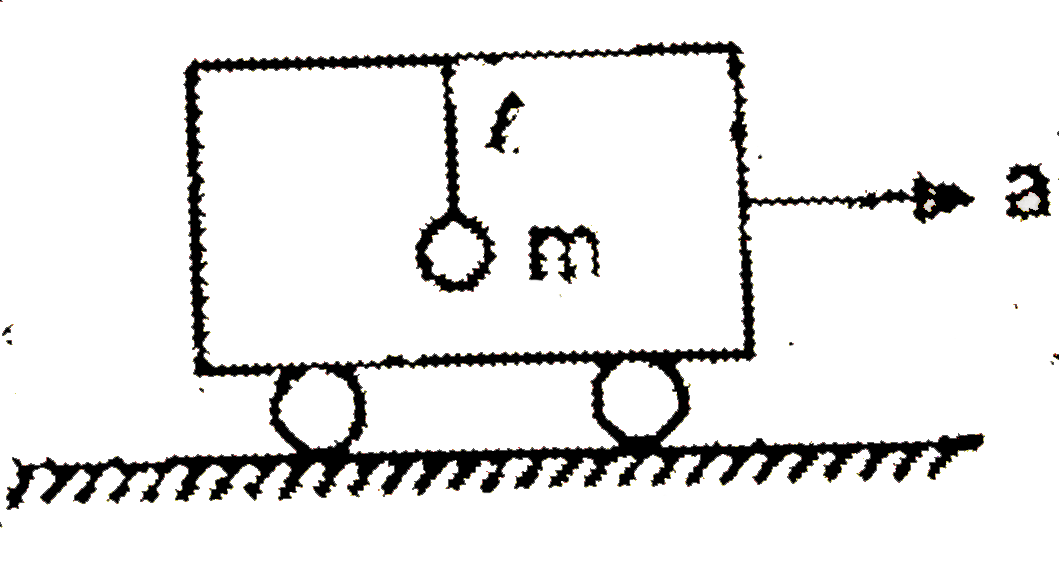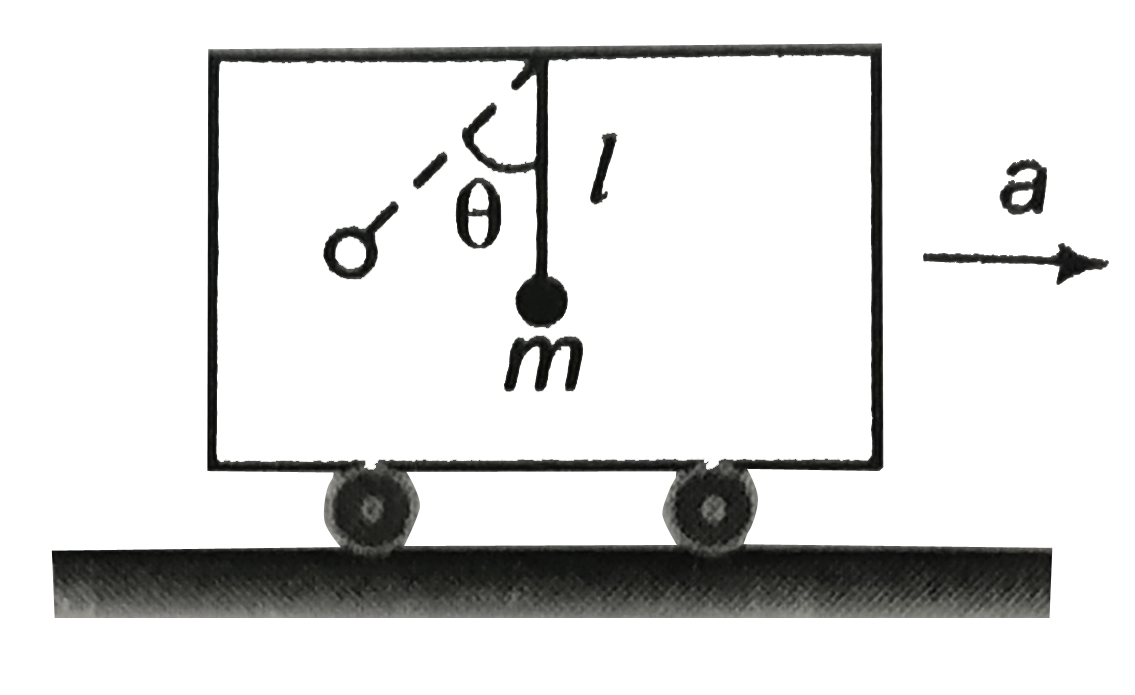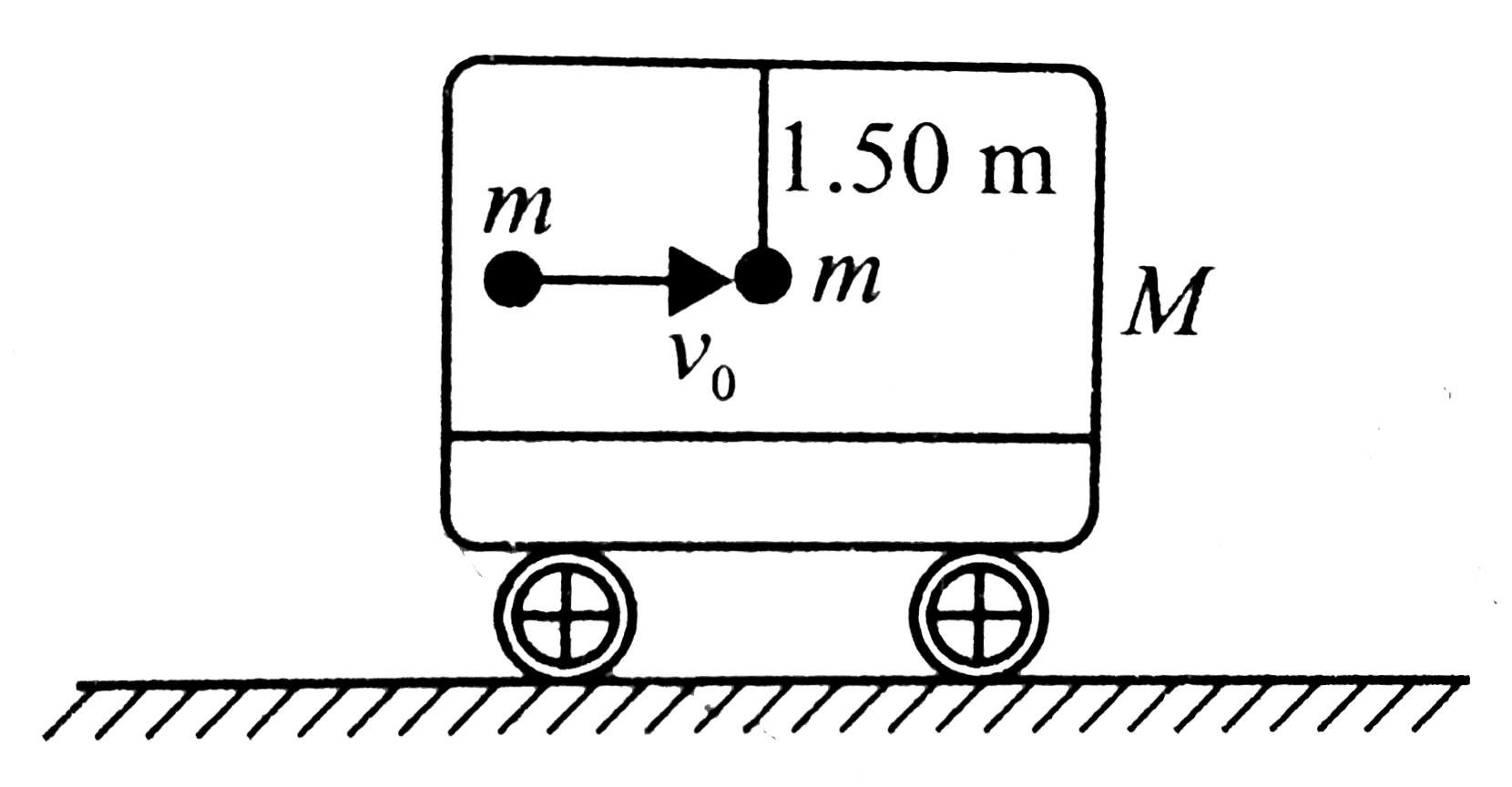In shown figure, the trolley starts accelerating with acceleration a. The maximum angle deflected by thread from vertical will be:

tan−1(ag)
tan−1(2ag)
2tan−1(ag)
tan−1(a2g)
The correct Answer is:C
Step by step video, text & image solution for In shown figure, the trolley starts accelerating with acceleration a. The maximum angle deflected by thread from vertical will be: by Physics experts to help you in doubts & scoring excellent marks in Class 11 exams.
Updated on:21/07/2023Topper's Solved these Questions
- WORK AND ENERGYBook:ANURAG MISHRAChapter:WORK AND ENERGYExercise:Level 2
Explore 18 Videos
- WORK AND ENERGYBook:ANURAG MISHRAChapter:WORK AND ENERGYExercise:Level 3
Explore 34 Videos
- WORK AND ENERGYBook:ANURAG MISHRAChapter:WORK AND ENERGYExercise:Eample
Explore 47 Videos
- UNIT AND DIMENSIONSBook:ANURAG MISHRAChapter:UNIT AND DIMENSIONSExercise:Matching Type Problem
Explore 4 Videos
Similar Questions
A pendulum of mass m and length l is suspended from the ceiling of a trolley which has a constant acceleration a in the maximum deflection θ of the pendulum from the vertical.

View SolutionIf trolley accelerates horizontally with acceleration a then bob is displaced backward from its initial vertical position. The angular deflection of the bob in equilibrium is

View Solution
Knowledge Check
The ring shown in fig. is given a constant horizontal acceleration (a0=g√3). The maximum deflection of the string from the vertical is θ0. Then
 Aθ0=30∘Bθ0=60∘CAt maximum deflection, tension in string is equal to mg.DAt maximum deflection, tension in string is equal to 2mg√3
Aθ0=30∘Bθ0=60∘CAt maximum deflection, tension in string is equal to mg.DAt maximum deflection, tension in string is equal to 2mg√3A ball of mass in m=1kg is hung vertically by a thread of length l=1.50m. Upper end of the thread is attached to the ceiling of a trolley of mass M=4kg. Initially, the trolley is stationary and it is free to move along horizontal rails without friction. A shell of mass m=1kg, moving horizontally with velocity v0=6m/s collides with the ball and gets stuck with it. As a result, the thread starts to deflect towards right.

The maximum deflection of the thread with the vertical isAcos−1(45)Bcos−1(35)Ccos−1(23)Dcos−1(34)When the trolley show in figure is given a horizontal acceleration a, the pendulem bob of mass m gets deflected to a maximum deflection , the net acceleration of the bob with respect to trolley is
 A√g2+a2BacosθCgsinθ−acosθDasinθ
A√g2+a2BacosθCgsinθ−acosθDasinθ
In the figure shown, find out acceleration of each block.

View SolutionA shell of mass 1kg is projected with velocity 20m/s at an angle 60∘ with horizontal. It collides inelastically with a ball of mass 1kg which is suspended through a thread of length 1m. The other end of the thread is attached to the ceiling of a trolley of mass 43kg as shown in figure. Initially the trolley is stationary and it is free to move along horizontal rails wihtout any friction. What is the maximum deflection of the thread with vertical? String does not slack. Take g=10m/s2.

View Solutiona small sphere of mass m susopended by a thread is first taken aside so that the thread forms the right angle with the verticle and then realease. (a) find the total acceleration of the sphere and the thread tension as a function of θ, the angle of deflection of the thread from the vertical. (b) Find the angle θ between the thread and the vertical. at the moment when the total acceleration vector of the sphere is directed (i) horizontally (ii)vertically upward and (iii) vertically downward.
View SolutionA ball of mass in m=1kg is hung vertically by a thread of length l=1.50m. Upper end of the thread is attached to the ceiling of a trolley of mass M=4kg. Initially, the trolley is stationary and it is free to move along horizontal rails without friction. A shell of mass m=1kg, moving horizontally with velocity v0=6m/s collides with the ball and gets stuck with it. As a result, the thread starts to deflect towards right.

At the time of maximum deflection of the thread with vertical, the trolley will move with velocity
View SolutionA ball of mass m=1kg is hung vertically by a thread of length 1=1.50m. Upper end of the thread is attached to the ceiling of a trolley of mass M=4kg. Initially, the trolley is stationary and it is free to move along horizontal rails with out friction. A shell of mass m=1kg, moving horizontally with velocity v0=6m/s collides with thread starts to deflect towards right

At the time a maximum deflection of the thread with vertical, the trolley will move with velocity
View Solution

